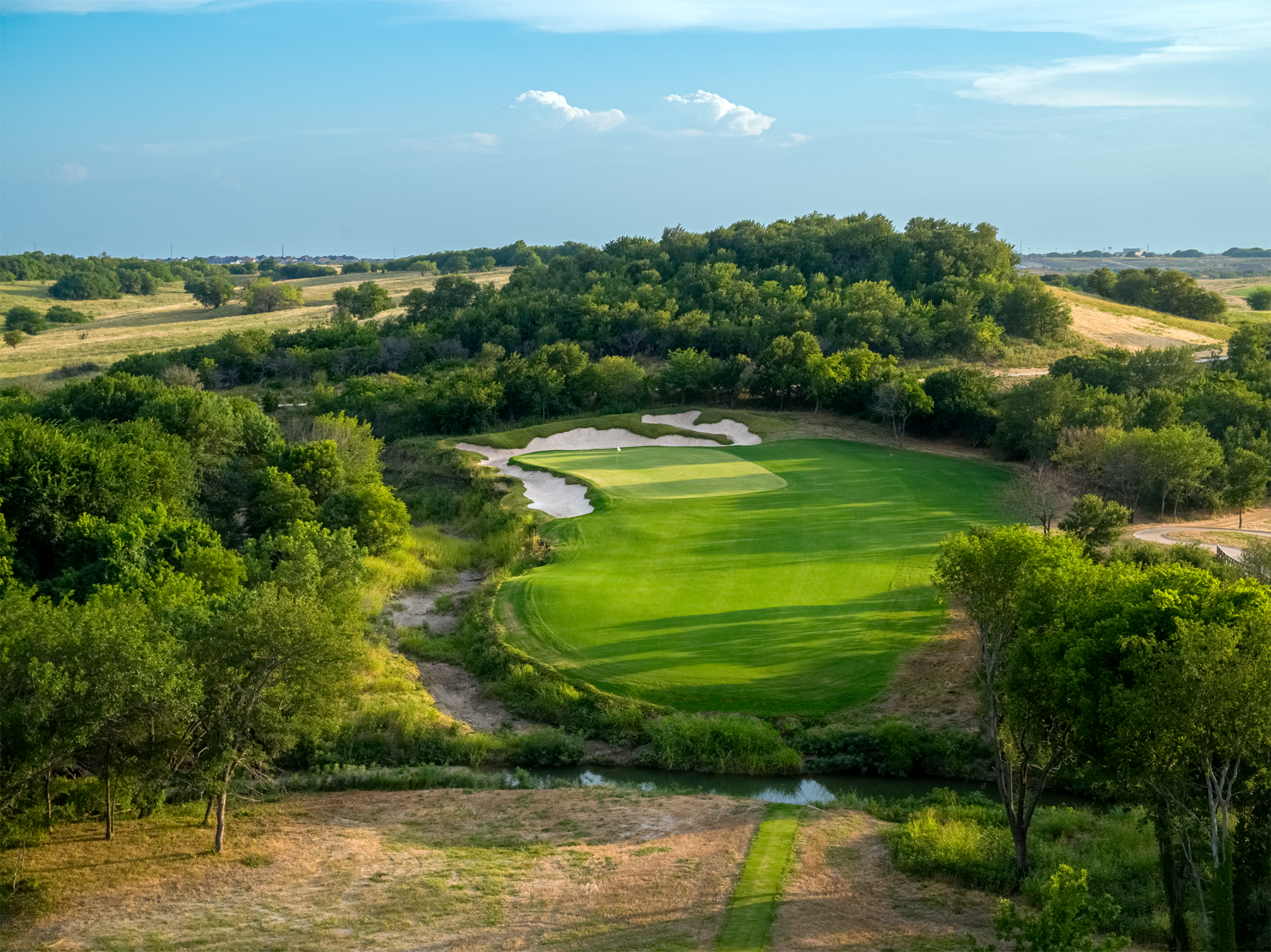Course Spotlight
A Closer Look at Fields Ranch, Host of the 2024 PGA Professional Championship
By Roger Graves
Published on

Fields Ranch West.
At first glance, you might not see the similarities between the Fields Ranch East and West courses that will host the 2024 PGA Professional Championship, and renowned major championship courses such as Augusta National, The Country Club, Baltusrol, Winged Foot, Southern Hills and Oakland Hills.
But on closer inspection, you will see the golf course architecture genealogy that links the two Fields Ranch courses at PGA Frisco in Texas to each of the aforementioned major championship venues. Yes, it’s difficult to compare Augusta National or Southern Hills to Fields Ranch at PGA Frisco just outside Dallas, Texas. But the lineage is there if you ask Fields Ranch architects Gil Hanse and Beau Welling.
Hanse and Welling are both disciples of architectural great Alister MacKenzie, who designed Augusta National and many additional gems in the United States. Plus, Hanse has conducted highly successful renovations of The Country Club, Oakland Hills (Donald Ross original design), Baltusrol and Winged Foot (A.W. Tillinghast original designs), Southern Hills (Perry Maxwell) and many other notable “major” courses.
But this time, rather than restoring a masterpiece originally painted by someone else, Hanse and Welling created their own courses from the ground up.

The 18th hole at Fields Ranch East Course.
Their masterpieces – Hanse’s East Course at Fields Ranch and Welling’s West Course – will add to their young pedigrees when 312 of the finest PGA of America Golf Professionals test the turf April 28-May 1 in the 56th PGA Professional Championship presented by Club Car, Corebridge Financial and Rolex.
“We’ve been fortunate to work on a lot of restorations of classic golf courses that have hosted major championships, and while we’re fully invested and that’s our work, it’s completely different when we’re trying to put Tillinghast back into Winged Foot or put Maxwell back into Southern Hills,” admits Hanse.
“On the East Course at Fields Ranch, it’s our design and our work of art,” he says. “It’s our ideas, our thoughts, what we believe about golf architecture, what we think ultimately will provide a good test of golf for the best players in the world.”
Welling, the architect of the West Course at Fields Ranch, doesn’t compare the course to Augusta National or to Cypress Point, but he was heavily influenced by MacKenzie.

“I was very fortunate growing up that we had family friends who were Augusta National members and family friends who were Cypress Point members, both designed by Alister MacKenzie,” reveals Welling. “So, hearing that man’s name was the first time that I even knew that golf course design was a thing. These two cathedrals of golf, the most special places I’d ever been as a young person, are what attracted me to golf course design. He remains our guiding light.”
Adds Welling: “The West Course seeks to take advantage of the natural character of the site that encompasses over 75 feet of elevation change and follows Frisco’s Panther Creek. The highly strategic nature of the golf course will encourage shotmaking and creativity from tee to green. We have designed the course with expansive fairways, averaging roughly 75 yards, to promote enjoyment for all levels of golfers, as well as to inspire different routes of play.”
The East and West courses at Fields Ranch were constructed simultaneously, but the terrain is a bit different for each. Matt Weinberger, PGA, Senior Director of PGA Member & Amateur Championships, says the closing four holes on the West Course can provide significant drama.
“A lot can happen between holes 15–18 on the West Course, with a drivable par 4 (hole 15), a demanding par 3 (hole 16) with a challenging green, and back-to-back par 5s to close it out on holes 17 and 18,” analyzes Weinberger. “As for the setup on Fields Ranch East, it’s remarkable how much it can vary based on the wind direction. I have seen the opening holes play incredibly difficult when played into the prevailing wind, and other times where they become scorable simply based on wind.”
The 2023 KitchenAid Senior PGA Championship was contested solely on the Fields Ranch
East Course late last May, with Steve Stricker and Padraig Harrington posting 18-under-par 270 totals, before Stricker won the title on the second playoff hole (the par-5 18th for a second time). The East Course will play 165 yards longer for the PGA Professional Championship than it did for the Senior PGA Championship.
Proving good shots were rewarded, the East yielded 17 eagles and 1,272 birdies for the week during the KitchenAid Senior PGA Championship, while three of the most difficult holes statistically were on the final nine. The 454-yard, par-4 10th hole was the No. 1 hole in difficulty, while the par-5 third hole ranked as the easiest while playing under par for the week.

One of the unique challenges at Fields Ranch East. (Evan Schiller Photography)
Competitors will have several risk-reward options on the two courses, including three potentially drivable par 4s.
“The holes that most lend themselves to being drivable are holes 8 and 15 on Fields Ranch West and hole 7 on Fields Ranch East,” says Weinberger.“All of those holes have significant risk/reward with a penalty area and bunkers lurking.”
The par 3s on both courses are also strong.
“My favorite par 3 on Fields Ranch East is hole 8, which really forces the player to think about the wind as it is quite exposed,” says Weinberger. “On the West Course, it’s hole 5. The green is extremely wide but narrow in depth and is surrounded by deep bunkers with an undulating green complex.

A stunning green complex at Fields Ranch East. (Photo by Evan Schiller Photography)
“For such a short hole, it can play so differently day-today, especially if the hole location is on the extreme left or right.”
The East Course, which will host all of the major championships currently scheduled at PGA Frisco, can stretch as long as just under 8,000 yards and places a greater emphasis on driving than the West, demanding length, accuracy and the courage to take on cross-bunkers and other hazards. The greens, perched above bunkers and chipping runoffs, are smaller and require controlled approaches, and the holes of the second nine wind through the basin of Panther Creek.
The par-5 18th hole on the East Course promises to be pivotal at the PGA Professional Championship, with trouble lurking from tee to green. The tee shot plays over wetlands to a diagonal fairway with Panther Creek to the right, requiring precise accuracy and ball flight. The green sits atop a bluff over the creek, so getting home in two will truly be a white-knuckle, risk-reward shot, with anything short or right in the water.
What more could you ask for with a spot in the PGA Championship on the line?


